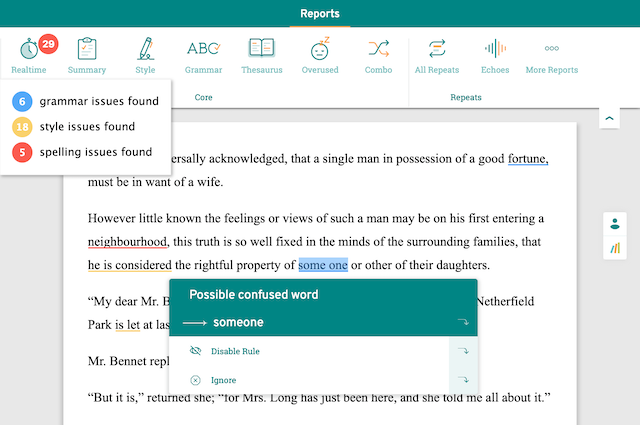
Does your class hate writing? If there’s no purpose to their work then that’s not surprising. No one wants to write for no reason.
It can feel like there’s a disconnect between the classroom and the actual world. Your students struggle to see the point of practicing writing skills when there’s no outcome to aim for.
We’re here to stop pointless practising. We’ve got 15 fun, creative, and inspiring ideas to put purpose back into classroom writing.
1: Write Reviews
Students enjoy making recommendations and telling everyone what they thought about a new movie, book, or show. It’s a great way to practise key areas of writing, including organisation and persuasive techniques.
Build reviews into your usual classroom routine. You could display them in the library, share on social media, or publish them on your school website.
2: Real-World Examples
Students rarely realize how much writing they encounter every day. Instead of making pretend classroom examples, use real-life blog posts, news articles, and product descriptions. Let them see how writing is used to inform and influence us.
After analyzing a real-world example, they can create their own interpretations. Place them next to the original version for students to compare.
3: Write Role-Plays
Younger children love pretending to be in adult scenarios. Many schools have specific role-play corners set up for students to play in. Introduce writing into this imaginative play wherever possible.
For example:
- Making a grocery store where students write shopping lists
- Creating a post office to write, address, and send letters
- Making a building site complete with hard hats, fluorescent jackets, and clipboards for writing important messages
Older students might be beyond dressing up, but they can still enjoy pretend scenarios such as launching a new product, scripting a TV show, or writing news reports. Have fun and record them performing. Make it an event and invite parents or other students to attend.
4: Showcases
Writing immediately has a purpose if it’s shown to everyone. Students will love seeing their work posted on the school website, as a wall display, or shared in a special event.
It’s the perfect opportunity to teach them essential proofreading and editing skills to make sure their work is error-free.
If you want to help your students visualize the editing process, use ProWritingAid. The Realtime Report will highlight grammar, spelling, and writing style errors.

Find an extract from a book, and alter it to include some errors. Then, open a blank document in ProWritingAid and paste your extract in. You can talk through the different writing suggestions and use the in-built articles, quizzes, and videos to make learning grammar rules interactive.
You could then give your class another extract to conduct their own "Realtime" report. They can compete against ProWritingAid to see if they get all of the suggestions right.
5: Write to Someone
Create opportunities for your students to write and receive letters from someone outside of their class.
You could:
- Reach out to a local care home for the elderly
- Write to children in hospital
- Set up a pen pal scheme with a school in another country
- Buddy new and prospective students up with older students to support transition
Letter writing lets students have freedom over what they say. Remember to explain what is and is not appropriate and always follow your school’s safeguarding policies.

6: Debates
Classroom debates are an excellent chance for a good argument. Your students will enjoy trying to beat each other with their persuasive words. Instead of pitting individuals against each other, try putting the class into smaller teams to reduce the pressure on any one student.
To make it more exciting, set up the classroom in opposing rows and let students vote for which team’s argument is the most convincing.
7: Speeches
Students love having the freedom to choose subjects of interest to them. Writing and performing speeches is their opportunity to speak passionately about the things they care most about.
Speeches are useful for teaching students to structure their writing and consider how they share essential information with the audience.
8: Class Blog
Seeing your work online is a wonderful experience. Your students will be proud to show their family their work published in a blog or on your school website. It’s a good way to engage parents and let them see what’s been happening in the classroom.
Use a free blogging platform like EduBlogs and let students type and upload their own submissions. Remember to teach them about online safety. Check the settings so you approve posts before they go live.
9: Make Books
Making a book is a fun process but also gives you a finished product to add to your classroom or library. Students can contribute to a class book or make their own mini ones. Don’t just stick to narrative writing. Class books are superb for non-fiction work too.
Try using origami to make a simple book template from a piece of paper. Laminate larger books to keep them from getting damaged in the classroom.

10: Creative Projects
Writing is a wonderful addition to other creative subjects, like music and art. Find opportunities to include writing in other art forms such as composing song lyrics, creating art installations, or producing poetry.
Writing doesn’t always have to be on a piece of paper. Try writing on different surfaces and textures. Let your students experiment with using a range of media and colors.
11: Outdoor Learning
There are plenty of opportunities to get writing outdoors. Your students could research and write about the natural world, creating poetry, fiction, and information texts based in nature.
Use writing as a part of a gardening project. Students can make seed packet descriptions, create recipes, and write regular updates to be shared with the school community.
12: Playscripts
There are many opportunities in the school year for students to write and perform simple plays. Younger children will love using familiar characters from films and TV whilst older students can invent their own. Use the scripts along with photos from the show to make a wonderful school display.
13: School Newspaper
Budding journalists will love using their investigative skills to write articles about school life. Set up a team and publish a regular newspaper for students and families to enjoy.
A copy of the latest edition makes a wonderful handout for prospective parents and guests to give a flavor of your school.
14: Enter Competitions
There are hundreds of writing competitions especially designed for young people. Look for ones that are free to enter and submit your students’ work. Often, they will receive a certificate just for entering, and there’s always a chance of winning a prize.
15: Real-World Issues
Harness your students’ passion for making a better world and get them writing about issues close to their heart. They can write to government representatives, newspapers, and even create their own awareness campaigns.
Final Thoughts
Classroom writing easily becomes boring and lacking in purpose. Injecting a little excitement and creativity helps you make it interesting and something to look forward to rather than a chore.
Talk to your students about the things that matter to them. Look out for local events and issues that could be a stimulus in the classroom. The more relevant it is to them, the more they’ll want to do it.


